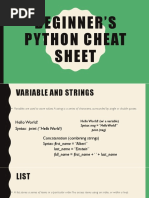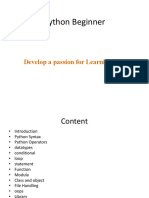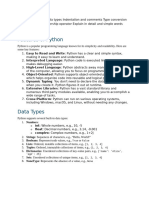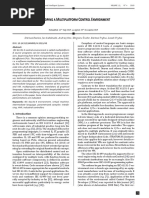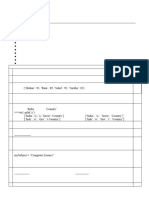Python Cheat Sheet
Uploaded by
gorrilaz59158Python Cheat Sheet
Uploaded by
gorrilaz59158Python Cheat Sheet
Basic Syntax Functions Syntax Lists
Comments: Function syntax: Creating a list:
# This is a comment def <name> (<parameters>): my_list = [1, 2, 3, 4, 5]
# inside the function
Writing to terminal: <function code> Accessing elements of a list:
print() # not inside the function my_list[0] # Returns 1
Variable syntax: A variable is created the moment you ‘def’ is a keyword defining that this is a function. Negative Indexing: Negative indexing means
first assign a value to it. Variables do not need to be beginning from the end.
declared with any particular type and can even change There are no return types for functions. my_list[-1] # Returns 5
type after they have been set. You can add a return statement and return any value.
variableName = value Looping through a list:
Function call: for x in my_list:
Data types: function_name() print(x)
Typ Description Examples
e Example: List slicing:
my_list[1:3] # Returns [2, 3]
int Integer (whole 103, - 12, def add_numbers(number1, number2): my_list[:-1] # Returns [1, 2, 3, 4]
result = number1 + number2
numbers)
return result Check if an item is in a list:
float 32 bit decimals (7 digits) 3.14 if 3 in my_list:
def greeting(): # Code for if condition is true
bool Boolean true/false print("Good morning!”)
Adding an item to a list:
str String "Hello" Working with Strings my_list.append(6) # Adds 6 to the end of my_list
Creating a string: Removing an item in a list:
Get data type: The type() function will return the type my_string = “Hello World” # Removes this element from the list (not using index)
of the given variable. my_list.remove(3)
x = 5 Accessing the characters: by referring to its index # Removes last item or the item at the specified index
print(type(x)) # Prints ‘int’ my_list.pop()
number inside square brackets [].
my_string[4]
Variable assignment example: Sorting a list:
x = 5 # Variable ‘x’ created my_list.sort() # Sorts my_list in ascending order
Splitting: Splits the string into substrings if it finds
x = “hello” # ‘x’ is type string
instances of the separator Reversing a list:
x = True # ‘x’ is type boolean
my_string.split(“ “)
Python Cheat Sheet
my_list.reverse() # Reverses my_list in place
conditionals: String formatting: Writing to console
if condition1: print(my_string) Reference Links
# code if condition1 is true
elif condition2: Concatenation (joining strings): - Python documentation
# code if condition2 is true # Combine two strings - Python Tutorial - W3Schools
else: new_str = str1 + str2 - Python Tutorial - TutorialsPoint
# code if conditions are false
# Returns the string with all the elements in the list joined
while loops: # together with spaces between them.
while condition: “ ”.join(str_list)
# code
Converting to uppercase or lowercase: returns the
for loops: uppercase/lowercase of the string.
for x in list: txt = "Hello World"
# code for each member of list # "HELLO WORLD"
OR print(txt.upper())
for i in range(10): # "hello world"
# code to repeat 10 times print(txt.lower())
Type Casting: String contains string:
str = "This is test"
Converting to an integer: int(string)
if “test” in str:
Converting to a string: str(object) print("Word 'test' was found.")
Converting to a float: float(string)
Generating a random integer number:
Syntax: random.randint(start, stop)
Example: print(random.randint(2,8))
- This example generates a random integer
between 2 and 8 (both numbers included)
You might also like
- Welcome To Data Science Online BootcampNo ratings yetWelcome To Data Science Online Bootcamp28 pages
- Welcome To Data Science Online BootcampNo ratings yetWelcome To Data Science Online Bootcamp28 pages
- Python for Data Science, AI & DevelopmentNo ratings yetPython for Data Science, AI & Development10 pages
- Familiarization with the Basics of Python ProgrammingNo ratings yetFamiliarization with the Basics of Python Programming47 pages
- 002 Python Variables and Python Data Types UpdatedNo ratings yet002 Python Variables and Python Data Types Updated16 pages
- Problem Solving and Computer ProgrammingNo ratings yetProblem Solving and Computer Programming16 pages
- XXXXX: Important Instructions To ExaminersNo ratings yetXXXXX: Important Instructions To Examiners22 pages
- Processing An Introduction To Programming 1st Edition Nyhoff Download PDF100% (5)Processing An Introduction To Programming 1st Edition Nyhoff Download PDF52 pages
- Rzonca-Developing A Multiplatform Control EnvironmentNo ratings yetRzonca-Developing A Multiplatform Control Environment12 pages
- Introduction To Network Security (Chapman & Hall - CRC Computer and Information Science Series) - Douglas JacobsonNo ratings yetIntroduction To Network Security (Chapman & Hall - CRC Computer and Information Science Series) - Douglas Jacobson502 pages
- Python Telegram Bot Readthedocs Io en StableNo ratings yetPython Telegram Bot Readthedocs Io en Stable371 pages
- Lecture 1 - Basic Python Programming Part 1No ratings yetLecture 1 - Basic Python Programming Part 195 pages
- Full Download Functional Programming in R 4 - Second Edition Thomas Mailund PDF DOCX100% (2)Full Download Functional Programming in R 4 - Second Edition Thomas Mailund PDF DOCX41 pages
- C-Variables, Data Types, Introduction To ProgrammingNo ratings yetC-Variables, Data Types, Introduction To Programming28 pages
- Embedded - PPT - 4-5 Unit - DR Monika-EditedNo ratings yetEmbedded - PPT - 4-5 Unit - DR Monika-Edited87 pages

